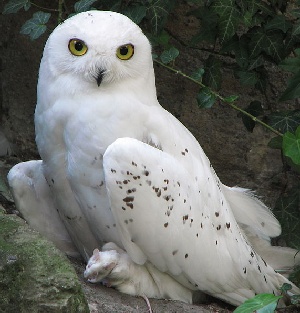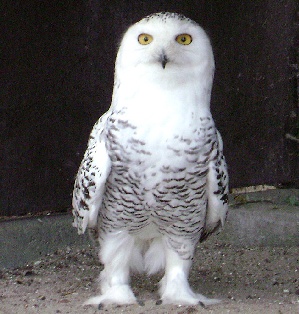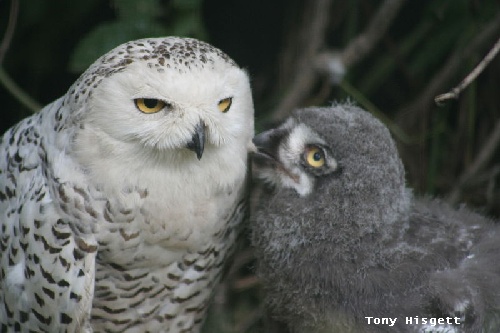 |
 |
 |
 |
The SNOWY OWL lives on the Arctic tundra in Alaska, Canada, northern Europe, Russia, Greenland. It is able to live there year round. This owl is covered with thick feathers from head to toe to protect it from the severe winter weather. If there is not enough prey the snowy owl flies south. It is a winter visitor in southern parts of Canada and northern United States. Then the owl returns to the Arctic in the spring.
DESCRIPTION
- height of 60 - 75 centimetres , wing span nearly 1.5 metres
- female is larger than the male and heavier
- adult male - almost pure white
- adult female - white with dark brown bars and speckles
- round head, large yellow eyes, black bill almost covered by feathers
- large feet covered with feathers; long, curved, black claws
- short bill, sharply pointed
- eyes do not move, swivels head from side to side
ADAPTATIONS
- coat - thick layers of down, with thick feathers on top
- even legs and toes are covered with feathers
- strong feet have curved claws
- claws catch and hold on to prey
- well camouflaged in winter
image credit - P.Bonenfant; Flickr.com ; Creative Commons License HUNTING FOR FOOD
- flies slowly, close to the ground, ready to swoop down on prey
- very good eyesight, can spot prey that is far away
- very good sense of hearing
- hunts during the day and night
- eats seven to twelve rodents a day
- prey : small mammals (hare, weasel, arctic fox, ground squirrels), birds and fish
- favourite food is lemmings
- swallows small animals whole, then regurgitate small pellets
- pellets contain bones, teeth, fur, feathers of their prey
NESTING AND RASING THE YOUNG
- prefers to nest on higher ground
- nest is a hollow in the ground
- nest is lined with feathers, grasses, moss
- an egg is laid every two days
- female remains on nest, male brings her food
- stays on nest so eggs do not freeze
- chicks (owlets) hatch in July
- hatch one at a time, every two or three days
- owlets have fluffy white down
- feathers change to grey, then white with brown speckles ( photo )
- parents kept busy hunting for lemmings to feed chicks
- note: if prey is plentiful, female may lay more than ten eggs
- Arctic foxes, jaegers (relatives of gulls) eat eggs and owlets.

PROTECTION FROM ENEMIESOTHER FACTS
- hisses and snaps when intruders gets close to the nest
- will dive at intruders
- illegal to hunt snowy owls in Canada
- a bird of prey
- also called Arctic Owl, Tundra Owl or Great White Owl
- scientific name - Bubo Scandiacus
| ARCTIC : ** INTRODUCTION ** PEOPLE ** ANIMALS ** PLANTS ** ARCTIC INDEX |
photo credits:
grey owlet - courtesy of John Piercy;
Flickr.com ;
Creative Commons License
information
Snowy Owl - Hinterland Who's Who , Canadian Wildlife Service